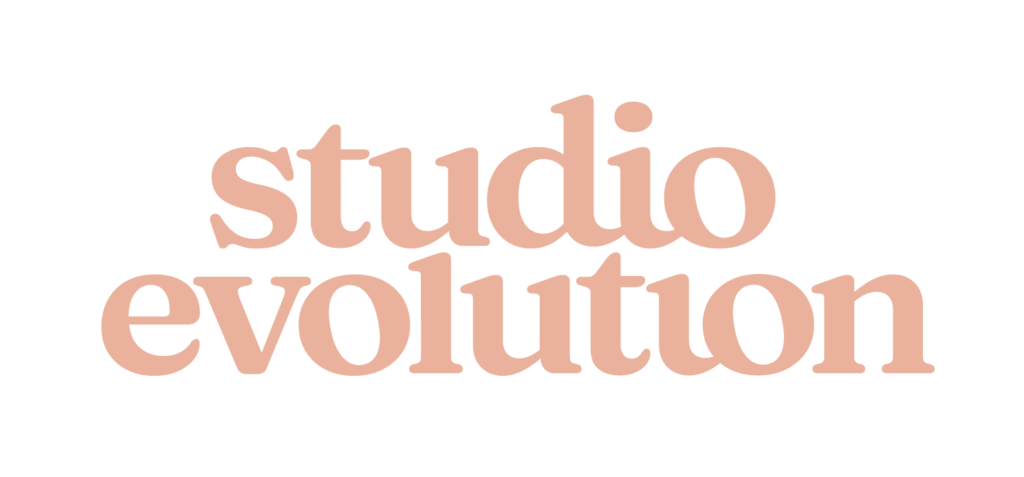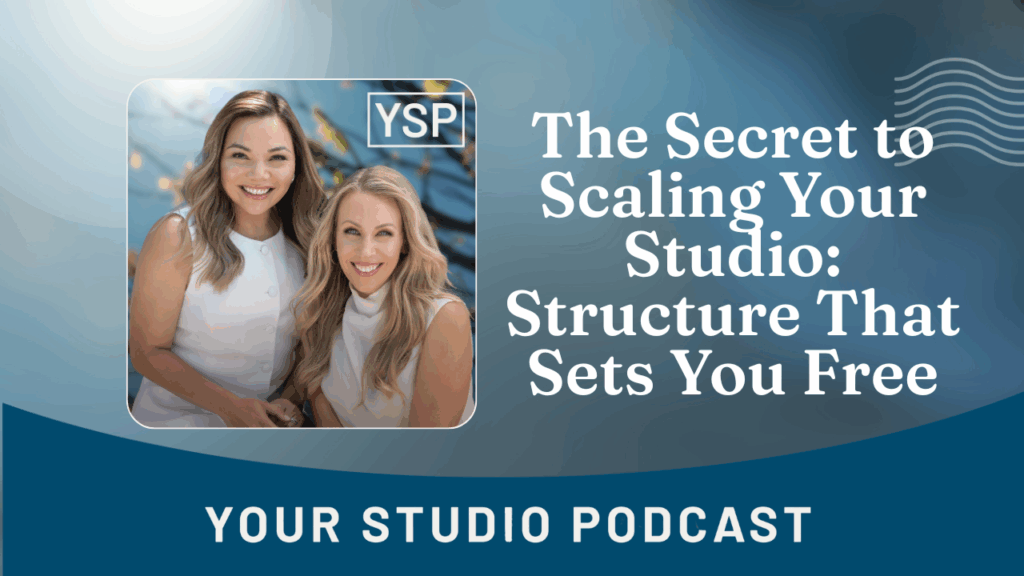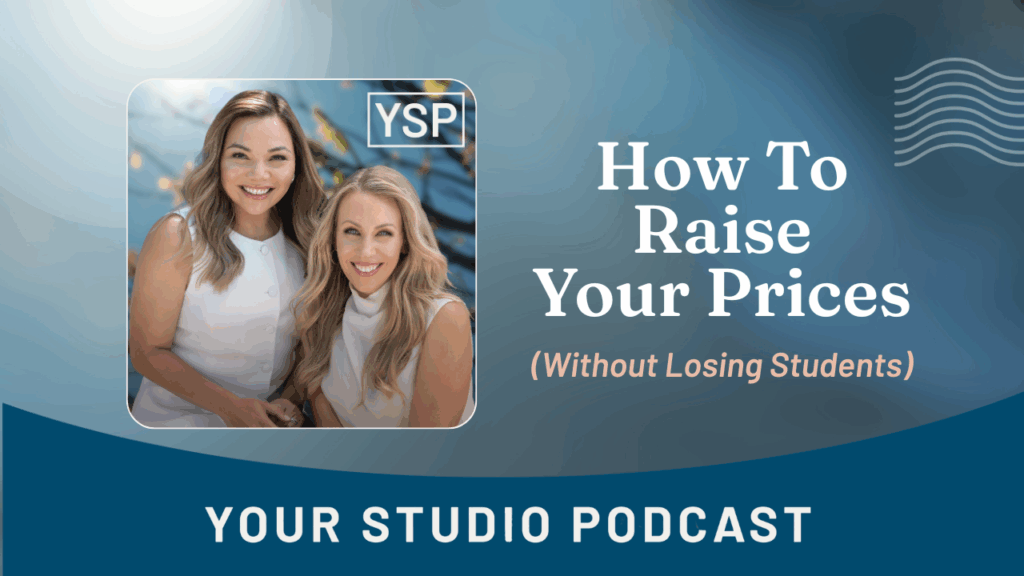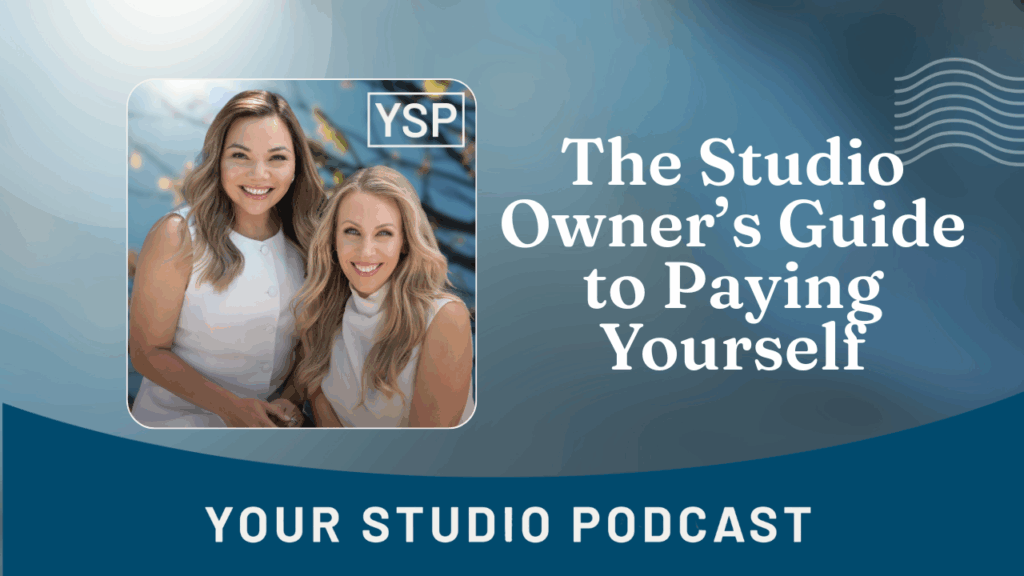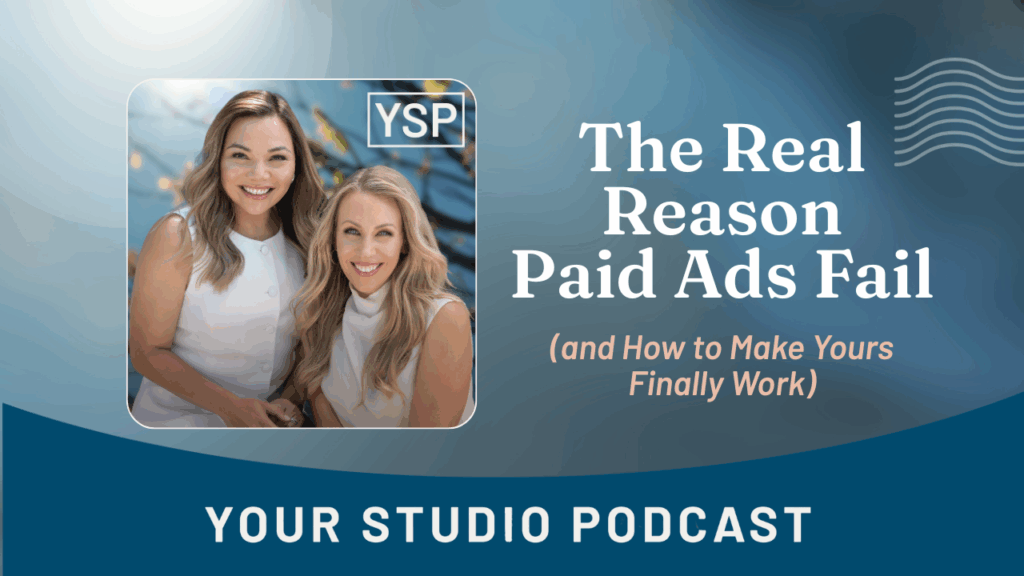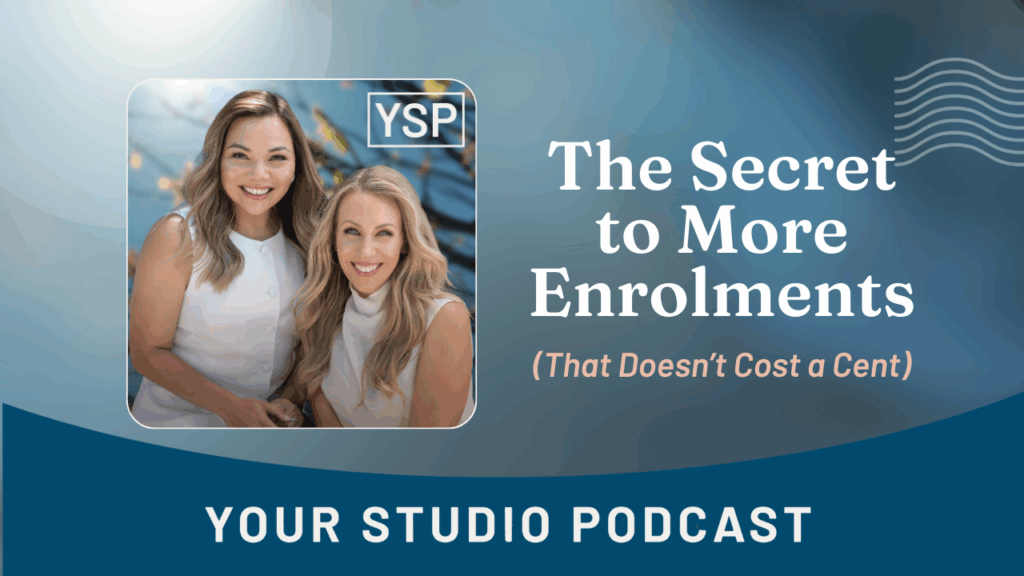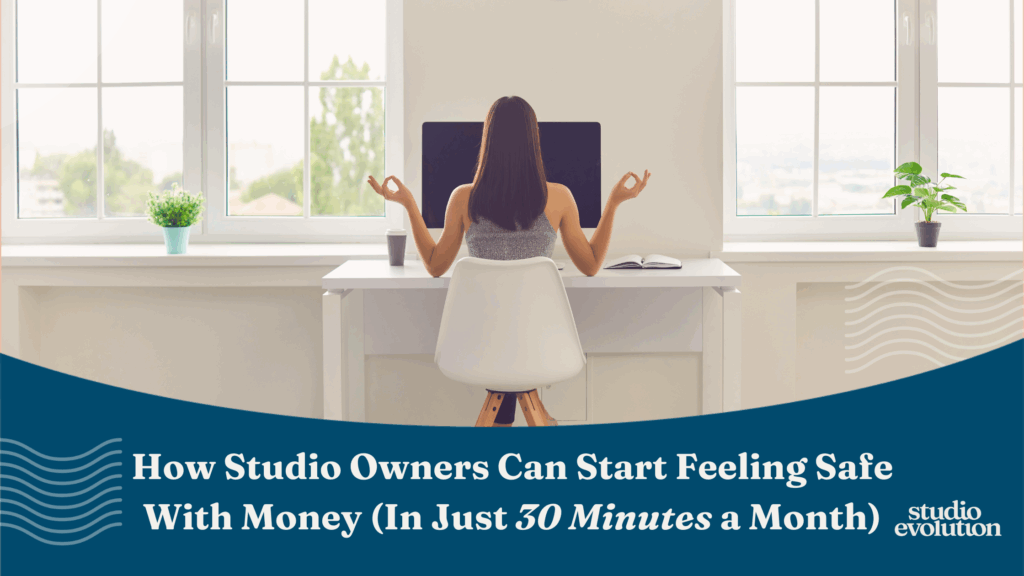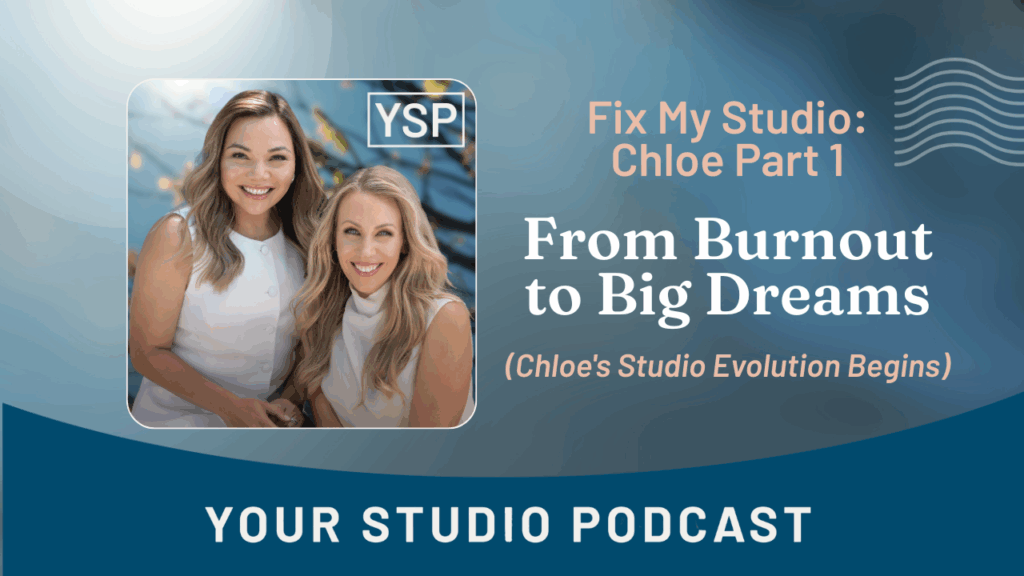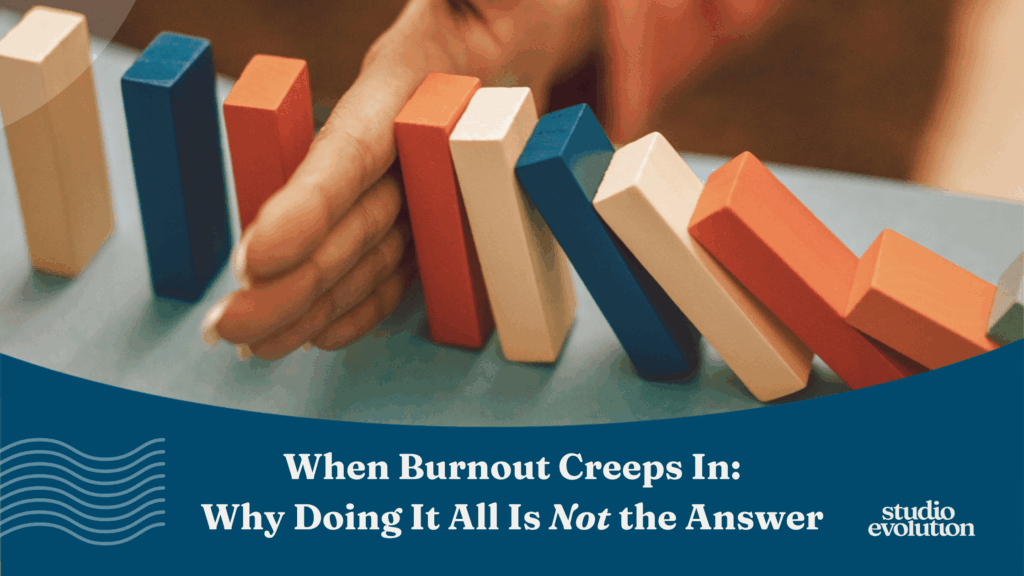Feeling like your studio is more complex than it needs to be? In this episode of Your Studio Podcast, Chantelle and Michelle talk through the 3 key shifts they’d make if they were starting over. These shifts are designed to simplify your programs, strengthen retention, and help you build a studio supported by a team, not just you.
Listen in for practical strategies and a fresh perspective on creating a studio that feels sustainable, aligned, and built for long-term success.
Please subscribe + review!
Voicemail: https://www.speakpipe.com/LeaveEvolutionAVoicemail
Instagram: @thestudioevolution
YouTube: @thestudioevolution
Facebook: @TheStudioEvolution
Website: studioevolution.com/start
Chantelle Bruinsma (00:34):
Hello. Hello, hello, it’s Chantelle here. Welcome to Your Studio Podcast together with my work wifey here. Michelle Hunter. Hello. Lovely.
Michelle Hunter (00:41):
Hi friends. How are we going today?
Chantelle Bruinsma (00:44):
Where are you listening to us? Are you on driving to the studio? Are you on a nice walk in nature? Oh, that’d be nice. Wouldn’t it be nice having a little coffee? So good. Well, we are going to be sharing some real talk today. This episode is all around the topic of if only we knew, if only we knew and what we might do differently had we known what we didn’t know at the time, right, Michelle?
Michelle Hunter (01:11):
Yep, yep. We’ve all been there. We’ve all been there. It’s like what would I’ve done differently if I started again?
Chantelle Bruinsma (01:18):
Yeah, and you think back to our younger selves, our less wise selves who didn’t maybe value our wellbeing maybe or didn’t.
Michelle Hunter (01:30):
Yeah, no, I agree. I’m just like, yeah, yeah, you got some lived experience. Just how long have we been in this game for 2020? Oh, let’s just block that kind of experience. We don’t want to go down that rabbit hole, but
Chantelle Bruinsma (01:45):
Oh my gosh. Oh my gosh. I mean, there are times I remember when I was working so hard, I would get a sinus infection. I had to keep working in my head. I did anyway. And I remember holding an ice pack to my forehead and still just typing away, just still doing the do. And I used to get so overworked from the 17 hour days that I was working that every kind of couple of months I would literally put myself to bed at dinnertime and then sleep the whole next day and the whole next night and then be like, okay, good. I’ve caught up and I can run. That’s insane. I was stress sick.
Michelle Hunter (02:24):
And the fact that you’d prepared yourself that if I just did that, I’d be okay. When I woke up, you knew the amount of time that you needed to sleep.
Chantelle Bruinsma (02:29):
I knew. It was a real strategy. I can just go and then after eight weeks or so, I’ll just have a day. I’ll just take a day. But I was running stupid fast, stupid fast, right.
Michelle Hunter (02:41):
When you’re in the moment, you just keep going, right? You just keep keep going. I remember back in the early days when we were launching and when we would launch an intake period and then we’d close cart. Normally we’d close cart at midnight. That’s a good time for Australia and obviously midnight and then also for Northern Hemisphere. And I would stay up till midnight with little kids at home to close cart. Why? So I could check the emails and just make sure, do all the redirects when you can do all that automatically. And I would do that launch after launch for years
Chantelle Bruinsma (03:19):
Because you just wanted to know it was done, right?
Michelle Hunter (03:20):
Yeah. I just wanted to know it was done right. I just wanted that satisfaction of clicking over, just knowing that it was redirected, making sure any other people in the inbox, it was just tidied up.
Chantelle Bruinsma (03:30):
Yeah, I mean it’s no real surprise friends why she’s now graduated to become a co-owner, right? A devotion and investment, I mean speaks for itself, but not ideal in terms of life.
Michelle Hunter (03:42):
Life, self-care. Yeah. But you know, making sure that I’m okay, so your work and productivity is okay. That’s not wise. That wasn’t a wise decision back in the day.
Chantelle Bruinsma (03:53):
Not sustainable. I remember with my studio, we were making zero money. I mean, I don’t even think we were making profit at this time and we were coming up to the performance and I had nothing, had no money to spend on costumes and I ended up spraying garbage bags in my garage at 2:00 AM the night before. So I got all these big giant garbage bags, cut holes into them for the neck. There’s a photo I can show you of this, this is real life. And then I got red and white, maybe gold paint and kind of spray paint them. And that’s, they put them on as it’s just, I cringe now, but that was what I had to do. There was no money, so I just did it all. Did it all.
Michelle Hunter (04:34):
And then after the getting high off the paint fumes, then you had to run the concert the next day, right? You look probably wasn’t at my best. But again, what would we do if we differently if we started again.
Chantelle Bruinsma (04:49):
I think we all open studios with rosy eyes of like, oh, the students and the connection and the impact and my gosh, the community and the memories and the relationships we’re going to make. And we just get so connected to what we can do that we don’t really have a strong understanding about the output required to do it. That’s the truth.
Michelle Hunter (05:12):
Right? And typically, let’s, you know, think of the studio owner. Well, typically when you open the studio, it’s not because you’re not opening it with the best business strategies. You open it, you’ve got a mission, you’ve got a heart, you’ve got a community you want to serve. And the strategy is not the first place where you go
Chantelle Bruinsma (05:33):
Because you don’t know it because you haven’t done a master’s degree in studio strategy. You haven’t done an MBA in this. So we are just kind of usually inheriting a lot of what we know to be true in the industry. So there’s kind of timetable strategy and the re-enrolment and the pricing kind of structures or this is kind of how it’s done and regardless that it’s maybe not very effective. And a lot of studio owners struggle on that model. We haven’t quite got the clarity at like, oh, maybe there’s a different way. And so we just keep plotting along and we add more programs and we work harder. We try and do more marketing and we get more overwhelmed and our schedule gets more full. And we know that the most effective way to make more money is for me to teach more. So you just teach more and you do more,
(06:16):
And then suddenly everything becomes more cluttered and there’s so many more balls in the air and we are left stretched in, stretched so thin. It’s not even funny. It’s not funny at all.
Michelle Hunter (06:31):
You’re maxed and you’re then left spinning all the plates and wonder how you got here. But can I just honor for a second as well, Chantelle, that’s why we love those studio owners. This is why we love you. You get into the game with all mission and heart and you’re so servant hearted and you want to create change and you want to create impact. And we love that and we see that in you. But yeah, when you get to the point where you’re spinning all the plates, it’s not sustainable.
Chantelle Bruinsma (06:58):
So I mean, I got there in my studio. I had this location running and we had 55 students and not making money but working a dog to not make money. And it gets to the point where I said to myself, either things have got to really change or I’m not able to continue. Was there, was there
Michelle Hunter (07:21):
A specific point? Did you hit a low point? Were you just exhausted? Were you chasing your tail or did you just go, nah, today I have to make a proactive decision to change?
Chantelle Bruinsma (07:32):
I think it was after we’d run another kind of big camp and we hadn’t made any money afterwards. And I think I kind of sat down. I remember being in my parents’ house
(07:45):
And kinda going like, I was maybe 20 at the time just for context. I remember thinking, this is not really working, is it? It’s not really working. And so I made the decision. I gave myself six months. I gave myself six months of either I can turn it around in six months or I need to just let it go. And maybe this is not for me. And just to accept that I loved it. The reason I started my studio was because I was studying at the Conservatorium voice in music education and I wanted a summer job. I wanted to go teach the performing arts summer camp, and I couldn’t find one in Sydney. I was like, this is outrageous. They were such a big part of my childhood. So just with all the gumption of a 19-year-old, just start one myself. But I had no knowledge of strategy. I had all heart. I love teaching. I knew how to create experiences and connection with kids, but I had no business strategy. And so everything that I did implemented from pricing to marketing, to systems to communication, it came from heart 100%. And people loved it, but it wasn’t good business.
(08:54):
And I think that’s the nuance of shifting from this is what I love to do, to this is a sustainable model
Michelle Hunter (09:02):
And this is what can create a legacy and create more impact and change more lives.
Chantelle Bruinsma (09:09):
And so the question really is what does the studio need to be? How does the student need to be structured in order to make this business incredibly successful? If we approach our decisions from that perspective of what kinds of programs we’re going to run, how we’re going to do marketing, how we’re structuring retention, how we’re doing our pricing, when we look at the decisions from that real perspective versus what just feels beautiful to do. And there’s space for both, right? There is space for heart-based and devotion to quality of education, devotion to community that aligns with solid business practice. And so in my case, I spent six months, six months learning, researching and thinking, reading a hell of a lot of books and doing a huge amount of research across the industry. I went and studied job descriptions for the biggest studios in the world, how they were approaching hiring. I analyzed so many timetables as not even funny. I now have an amazing knowledge bank of timetable strategy because of even that knowledge and pricing models like what the increments are and how to structure them by minutes or by packages. And all of that learning was came from the product of my studio. My business is not fricking performing.
(10:30):
This is not working and I’m not here for this. I would be better at getting a job at the local cafe is the truth. I would be so much financially ahead if I was doing that. And I had so much privilege, I was still living at home. So I really was very lucky to be the age I was where I was studying full time. I didn’t have overheads, I didn’t have scary kind of things. I was at that stage in my life. I had that opportunity. So I want to really make that clear. But at the end of the day, when you get the model and you kind of do things from a place of really not just hoping, but really clear, magic just happens. And so this was, again, I had 55 students in July. I spent the rest of that year really considering strategy and structure and architecture of systems and intention for experience. And I set a big goal. So in this process I was like, I just don’t want one location. This is classic me.
(11:28):
So I decided that there was this business in the UK that I thought was amazing, and I researched their kind of operation kind of philosophy. I thought, well, here in Australia, if I’m going to do this, I could see us having 25, 26 locations. And so I built this model based on that. And so as we grew, when I relaunched, we went from 50 55 students in July. I kind of relaunched again for the February, we had 114 students by February. So we doubled in that six months. And then the year after that, we opened our second location year after that third location, fourth, fifth, sixth. And the rate of growth was just beautiful because the model worked. And I think so many of us are stuck in spray painting garbage bags in our garage
(12:16):
Because we haven’t got the money, but we haven’t quite got the opportunity to kind of reset. And so what we’re going to talk about in the Podcast today is if you could start fresh, if you could hit the reset button on your business, what would you do differently? What would you set up without any of the fear of to change our pricing model would be so stressful. Or to look at doing our timetable. We had a conversation with one of our members in The Leap just last week of she’s got 30 minute classes, but the scheduling isn’t absolute overwhelming consuming part of her world. It takes up her life to work out the scheduling for a studio. We’re talking about what if it wasn’t that way and her fear of, but how people are going to respond but it’s not working. So we sit in this tension of like, well, I’ll just kind of absorb it. I’ll just kind of tolerate it because I’m scared of if I change things, what’s going to happen. It’s nowhere to live. It’s nowhere to live.
Michelle Hunter (13:16):
It’s heavy. And then you’re carrying that while you’re still churning up and teaching classes as well. It’s a lot. It’s a lot.
Chantelle Bruinsma (13:26):
It’s a lot.
Michelle Hunter (13:27):
Let’s go in. And Chantelle, I know that you did this in your own studio, Born to Perform, but you’ve also mentored thousands of studios and hundreds of studio owners as well in evolution through this process. So I want to hear if you had to do it again, where would you start?
Chantelle Bruinsma (13:46):
Okay, this is such a fun question. So if I could literally play and like walk into a studio and go like, okay, we are going to build the ultimate prototype. Isn’t that fun, Michelle?
Michelle Hunter (13:55):
This is really fun.
Chantelle Bruinsma (13:57):
So if we’re going to design this ultimate prototype, there’s three things that I would really be focusing on and the first one is retention. Most studio owners really focus on new enrolments and you have to right? Normal, great, go for it. However, I feel that chasing new enrolments and turning on the taps of advertising, working on getting more students through the door, come, putting all the effort in without working on retention is putting a bucket over a tap. But the bucket’s got holes in it. It’s like chasing this leaky bucket. You’re never going to grow because if you’ve got students coming at the bottom and you’re not holding them, you’re never going to fill up. So it’s so much more work, it’s so much more momentum you’ve got to create in your marketing. It’s exhausting and relentless. So for me, it’s about the first thing to think about is if we were to design a model that put at the heart, because for every student we get through the door, if we’re able to retain them for 10 years or however long you’d intend to retain them for, gosh, we’re going to grow quickly. The compounding of retention is undeniable. And the sooner you get processes in place for retention, the better. So I’d be thinking about things like how we’re designing our culture, how I’m designing our program flow,
(15:16):
How I’m designing our intentional communication, inviting people and educating ’em about the next step in the process. I’d be thinking about how I’m doing onboarding to from the beginning, paint the picture of expectation that this is where you’re going to go, really being much more clear on the journey that they’re going to walk on through your studio. I can’t talk, have you noticed, I’m just actually mumbling every third word.
(15:42):
It’s fine.
(15:44):
It’s fine. So it’s being much more clear on what you want retention to look like in your business. And I know that some studio owners think that retention’s fluffy, but for me it’s money.
Michelle Hunter (15:59):
It’s funny, it’s such a new take when people start to work with us too, Chantelle, isn’t it? Because we’re so ingrained that more students equals more money. If I’ve got to make more money, I’ve got to grow. But when they come to work at you like retention is pivotal. And it’s not just
Chantelle Bruinsma (16:14):
Why I like retention. I like cashflow. I really like stability. I really like money in the bank.
(16:22):
I really do. And retention is the best way to do it. And it’s money that feels good because when you’re retaining students, it means it’s like it’s the best report card you’re getting on the culture and the quality of education you’re giving and the community you are sustaining. For me, it’s the best indicator that we are doing things well and that our mission is being really realized across the studio, but it’s not fluff, it’s strategy. How you link programs together is strategy. When you do the invitations to the next level is strategy. There’s times to do it in the calendar of the year and there’s times not to do it. And when you get clear and oh my gosh, this is the precise window to seed, this is the precise way to get them excited for the next thing. And this is the precise way to invite them over with some impetus. Life just becomes really damn easy. You can sleep well at night. So I want a business that is rock solid and stable. And the best way to do that is to have long-term retention strategy built in. And I know I’m evangelical about this, Michelle, but I think it’s pretty life-changing.
Michelle Hunter (17:27):
It is. And it doesn’t have to be something that you manually do all the time. When you get really good at your retention strategy, you can have this kind of automated as well, some aspects automated scheduled in training with your team and it really can be so transformational and drive mass growth. Isn’t it Chantelle? Because when the retention’s locked in and you do have a big intake period, it can transform a business.
Chantelle Bruinsma (17:49):
Here’s the thing, I believe that with retention, you can actually be the architect of it to the degree where you don’t need to hold it. The model of the business actually sustains the retention by design. So how a student flows through the natural architecture, it’s kind of like karate, right? Like black belts, you start on white these and then it goes to yellow and then what’s the next one after that? Michelle? I’m not very sure a color.
Michelle Hunter (18:16):
A color.
Chantelle Bruinsma (18:16):
Your husband is the Pan Pacific Jujitsu, but there’s a different grading system, isn’t it?
Michelle Hunter (18:21):
It’s a different grading system. But as you go through the colors, they just know because working towards the next belt and it’s just so clearly laid out to them, they know what they’re working towards. And it’s the same in a studio. Lay out the path, lay out the journey, and they know where they’re going.
Chantelle Bruinsma (18:35):
Otherwise we’re just hoping they’re going to be motivated to some invisible carrot.
Michelle Hunter (18:39):
Yeah.
Chantelle Bruinsma (18:39):
People need carrots.
Michelle Hunter (18:41):
That’s right.
Chantelle Bruinsma (18:42):
It’s very interesting. Even like the data, when we brought in the Tiffany’s graduation gift, isn’t it fascinating how kind of people were uploading more projects, our retention is improved.
(18:54):
If people have this momentum, they know where they’re going to go. They know why they’re doing it and what they’re going to gain on the other side, engagement increases strategy doesn’t require anything more of me, but the business is built to improve retention and that’s what we’re all about. So that’s number one. Designing this whole business model with retention at the heart, what is going to keep people connected, motivated, driven to continue. People need a goal that they’re moving towards. They need clarity. They need a container, if you will. If you’re not holding them in something with an idea of progression, they’re going to fade away into the distance. You need to give them something they’re moving towards. So it’s number one. Number two is kind of adjacent to this, it’s business model, but from a different sl. And that is many studio owners think that as they go along their journey, they start, oh, someone says like, oh, could you do acro classes? Sure, we can run acro classes. Could you do meditation week retreats on the weekend? Yeah, I can do that. No worries. Could you start a ukulele group? Yes, yes I can. And what happens is that we add more programs and every program you have is having another child. I want you to think about how many children you are currently feeding in your house right now, right? Michelle has three children.
(20:18):
Yep.
(20:20):
I have two. It’s enough.
Michelle Hunter (20:22):
It’s a lot. It’s enough. It’s enough. We’ve come to our max, we’ve reached our max.
Chantelle Bruinsma (20:26):
Shop, be shut, shop, be shut. But the thing is, every single program you have, which is beginner, ballet and kind, then contemporary or lyrical, every kind of different genre you have, every kind of different structure you are holding requires intentionality and requires marketing. So you can get it to capacity. It needs a flow of communication aligned with it. It needs teacher training. So one thing that we are super, super duper passionate about doing with our clients is reducing the program offerings to be much, much, much more refined. Now, when you’re able to do this, it puts, it’s kind of like a funnel as opposed to putting water across lots of different cups. We consolidate the program suite to be less intensive, which means we’re only marketing fewer programs, which means we’re going to get more intake. It means our timetable is less congested. It means our teachers are more trained. There’s more flexibility in covers the program. Having less programs is the key. Some of our most successful clients, and I want you to really listen to this, some of our most successful clients, and I’m talking like a thousand plus students have one or two programs, maybe three.
(21:45):
Mass niching, getting really clear on this is what we do really well, this is what we are really passionate about. This is what is also highly profitable. It goes back to that whole hedgehog concept from good to great. If you know that model, what we are best in the world at, what we’re passionate about and what drives our economic engine. When you come from that place of we don’t need to run all the programs, how can we consolidate this into more of a kind of smorgasbord of inclusions within this program? So can you structure the business model in a way where things are more integrated and less kind of itsy bitsy a car? The more a la carte choice you have, the more confusion and communication required to sell it, which means it’s hard to get people through the door. So you’re wanting to really think particularly front facing when we’re talking about marketing the studio, we kind of want some just real front facing programs that are easy to sell, does do what they say on the box and really get people in the door.
(22:38):
And then internally, really how we can simplify that flow of retention all the way through institute evolution. We have a project called Roadmap, which is about taking a student from day one of the studio right through to when you want them to graduate. I want ’em to be here for 13 years. I want ’em to be here for 25 years. Let’s actually map how they’re going to move through it in the ideal most streamlined way. And it is revolutionary. It’s just like, oh shit, I am doing So there’s so much complexity over here. It’s not serving the business. So the business model is something that needs a lot of attention.
Michelle Hunter (23:11):
And it’s huge. And we’ve seen this business model transformation take place so many times, but for the listeners playing a home and may be a hyperventilating at the thought of changing your whole business model, Chantelle, because I know there’s a huge personal and emotional piece here because I’ve seen it in a lot of studios where they want to be the one that offers and appeals to everyone. I want to say yes to all the parents, I want to cover the masses. It’s that mindset. What’s the biggest kind of change you see when we do change the business model, done this in person and we see this in our programs, is the hardest thing to let go of.
Chantelle Bruinsma (23:48):
Because it’s the hardest thing to let go of because people love the programs and you can deliver them. It’s the truth, it’s the cost of delivering it that it’s the unspoken thing. When you’re delivering programs that aren’t viable, it’s like the studio is carrying really heavy weight and we’re leaning on the other programs and we’re so consumed with trying to keep those programs going that our attention is taken away from more scalable ways of growing the studio. It’s really tough. I know this is really tough.
Michelle Hunter (24:21):
But we have seen that link to burnout as well, studio owner burnout, haven’t we? When you’re carrying all those programs and we’ve actually seen studio owners flourish before our eyes when they’ve dropped the dead weight as well.
Chantelle Bruinsma (24:32):
Well, that’s right, that’s right. I mean literally this is so, so important. I think back to, we had a lovely client based in California, Martin and Daniela, and they were just doing so many different things and we just really dialed in. Here is where you start, and we worked on the retention for this kind of first introductory program. In one year of working with them, they added 1,836 more individual private lessons to the timetable in a year. But that’s huge.
Michelle Hunter (25:05):
That’s bonkers.
Chantelle Bruinsma (25:07):
Yeah, yeah, enormous. And then their retention in four months of getting more intentional about how we’re kind of moving people through, we’re kind of getting ’em in the door. They went from 28% retention to 66% retention. And again, this is where from that first point I was talking to you about, we can be so focused on marketing, but Martin and Daniela, they ran a Arthur Murray Dance Studio in Sherman Oaks, Sherman Oaks. They were so focused on getting more people through people through the door because they had 28% retention. So you’re having to hustle, hustle, hustle, hustle, hustle, hustle, hustle. But when you shift the retention strategy and you get the business model, it’s very clean, it’s very clear, it’s very easy to sell, it’s very straightforward. There’s less complexity and you improve the communication strategy of retention. To go from 28% to 66% retention in four months is life changing of what’s going to happen from there.
Michelle Hunter (26:04):
Massive cashflow change into your daily life.
Chantelle Bruinsma (26:07):
And just effort. I think so many of us are holding business models that aren’t necessarily serving us because they are how they are and our fear of change is real, right? Yeah, it’s real. It’s hard to do these big decisions. It’s particularly hard to do them on your own. Our clients are able to do them because they’re held, because we’ve got an expert mentor who’s there by their side, kind of like, have you thought of this? Let’s make sure we do this. Let’s get you really prepared and settled and confident to be able to make these moves and decisions. And we’re providing them with enormous sense of resources and choices of different ways to approach this. It’s hard to do it when you’re just stabbing in the dark. We don’t know what we don’t know.
Michelle Hunter (26:50):
So true.
Chantelle Bruinsma (26:51):
We don’t know what we don’t know. So number two is to really reduce the complexity in your business. It’s incredibly hard to do on your own, but it’s one of the most important things to see leverage and growth. It’s like thinking about Apple. They don’t offer enormous customization. They don’t offer enormous kind of product lines. It’s pretty minimal. Your studio should feel similar to that. Number three, the third thing I would be really thinking about and that I thought about when I was designing Born to Perform, my studio was on team. So if we’re going to grow this business of yours really significantly, we need to make sure that we are putting team at the heart of these decisions and how the team can help grow this business. What’s going to happen is initially with my studio, when I started, I was everything.
(27:43):
I was the toilet roll changer. I was the marketer, I was the welcome team, I was the finance executive, I was, you name it, right? But that’s only going to last us so long. And I was also the main teacher that’s only going to last us so long. That’s not a viable long-term solution. So it’s thinking about how this business of yours could retain all of the heart, all of the care, all of the excellence, all of the devotion, all of the meaning you bring to every class, all of the culture and connection you create. How can we do this in the same way whilst delivered by the team on mass? So again, I was looking at having 25, 26 locations for my studio. I got to six, but I had designed out a very progressive model that worked. Like when a teacher came to work in Born to Perform, they had to work with us for a particular amount of time, nine months where they were in the first role, and then after nine months they could apply to go to the next kind of tier of experience and they would get a pay rise and then they had to do another nine months of experience in that one.
(28:47):
Then they could become an assistant leader and then after they become a leader and then they could open a new venue. So when I hired people, I had a very clear ascension model of you start here on your first day as a kind of someone on our team, but here’s the trajectory you’re going to go to be opening new venues for us. I was really clear on how people could move through the company because I bet there’s times when you feel you were the center spoke, the center of the hub of the wheel. This is only going to work long-term when you are not, you’re not. So if I was in your situation and going to do things differently, I would be spending a lot of time playing with org charts thinking about, okay, could I get someone leading curriculum over here? Could I get a concierge role doing customer care here? Could I get someone getting a bookkeeper? I would be playing, just play what could be possible. You don’t need to pay for it overnight, you don’t need to pay for it right now. But just thinking about what would this org chart look like that would facilitate the dream that you have because the dream is not going to happen. Our team, team are going to be the secret to your growth, Michelle. We can’t do anything without our Dream Team.
Michelle Hunter (29:59):
And our Team is so important and having the right people in the right positions is so important. And Chantelle, if we’ve got studio owners who are still solo, so still they’re on the cusp of big growth now and they’re doing all the things, they’re going to change. What would be the first hire for the team to start?
Chantelle Bruinsma (30:19):
First thing is to free yourself up for more leadership work. So more kind of time to work on the business. So if you can get a second teacher to kind of work with you, that would be probably number one. Number two, hire would be someone to get into the admin side. So someone managing the inbox would be the first thing that we would be wanting to do. And you can get that from Microsoft. Five hours a week will change your life and get you unchained from the inbox, right Michelle?
Michelle Hunter (30:45):
Yeah, completely. And sometimes when we talk to studio owners, we equate it with how many enrolments do I have to get just to cover that. Sometimes it’s one student, sometimes it’s two. But it’s like if I get two student that covers a five hours a week and it will get me out of working in the business to own the business.
Chantelle Bruinsma (31:01):
It’s really, really important that you have the time to get this business model right? Because the more that you are free to grow the studio, the more lives you’re going to impact, the more growth you’re going to see, the more fulfillment you’re going to gain. It’s kind like doing more of the same, gets you more of the same is the unfortunate kind of tricky truth. Sometimes we’ve got to kind of try a different pathway in order to get different results. And so the letting go process of maybe I could align with this bigger vision of the studio and step towards it is the path.
Michelle Hunter (31:38):
And we’re not meant to do it alone. That’s the great thing about having a team. You’re not meant to be doing this alone.
Chantelle Bruinsma (31:43):
Yeah, that’s the hard thing. It’s really hard. You can’t do it alone. It’s not impossible. In fact, it’s not impossible. You need support to enable to make the big decisions, to be able to be illuminated to other choices you have. We’re so siloed in our businesses of like, well, this is how I do it. This is how my pricing model works. This is how my timetable is. Maybe there is an optimized way to do this that would get me better results, but I don’t know them
(32:10):
So I’m just going to keep doing what I do. And unfortunately when that kind of all compounds, it can make you feel really stuck. So the biggest question I want to ask everyone right now is if you could start again, what would you do differently if you weren’t scared about what people would think or what their pushback would be or how much work it would be to make these changes in your business? What would you do? What would you do? Super interesting how Michelle.
Michelle Hunter (32:37):
And you know, send it through to us. Put it in the comments below and we’d love to hear it. We’d love hearing studio owners when they reflect and they go back and reflect what they would’ve done differently. And it also shows you how far you’ve come now as well. We’ve got a lot of studio owners listening in who have been through The Leap, who’ve been through Studio Evolution and from thinking back to where they were a long time ago in their journey to where they’re now, it’s just profound.
Chantelle Bruinsma (33:01):
Oh my gosh. And when you compound retention with good marketing, life gets really fun. It’s magic. It’s because the classes are getting filled and they’re getting filled and you get to wait list and then it’s like you’ve just got this momentum of board of mouth enrolments and that comes when you’ve got really good retention. It’s this beautiful cycle. So I want you to have really incredible connection with your marketing and for it to be working and supplement that with retention that when you get that new student through the door that you’ve worked so damn hard to get, they stay for a good decade. And we get that relationship, we get that connection, we get that transformation and our business gets the stability as a result. So it’s those two things combined. When you get the model that gets that attraction is easy and the attraction kind of fuels the retention. You golden my friends, you are absolutely golden. So when you step into The Leap with us, this is working on first of all, it’s not just marketing. It’s really kind of looking at the identity and who we’re creating a community for and making it easier for people to step in and really kind of improving how you market. We’re going to look at what your front facing marketing is and get it all cleaned up to be truly aligned
(34:15):
with who you are. I think so much studio marketing is this kind of generic kind of blah blah, like fun, friendly lessons and there’s too much competition for that friends, it’s too easy to be stuck. What we do in The Leap is we get right to the heart of your identity as a studio and we bring that into very strategic marketing communications that are bit to be used in advertising in your website and in your inquiry process. And we teach you how to do all of that in just six weeks. It’s game bloody changing and we’d love for you to join us. So if you want to head to studio evolution.com/leap, you can literally jump on board and start watching the first video today and we’d love to support you in that process of really making marketing growth easier. But a part of The Leap. We do these kind of monthly coaching calls and this is where I’ll be sharing with you information about retention and how to optimize this in your business and how to kind of link the attraction with solid marketing strategy so you can get the growth and get the ease that you deserve. Michelle, big. Cool. It was a big one today, Chantelle. Let’s do a recap.
(35:19):
So if we were to start again and if you had the chance to really redesign your studio, we’d be thinking about three things particular number one, designing it for retention, stability, cashflow, consistency, sleep at night. Number two, we are really working on reducing the complexity in the business because that’s what’s going to help you scale more is not more, less is better, easier for marketing, easier for scale. So really looking at what we’re offering and why and bringing the heart of your intention back to that. And number three is team, how we could set this up to be really enabling the team to allow them to grow this vision of the business alongside you so that you are not the kind of dog’s body doing everything all the time. How this business is going to grow without you doing all the things. So having a bit of a vision for that is a really important step of having this goal for your business.
(36:11):
The other thing is just to think bigger friends think bigger. We get so stuck in this is what it is. It doesn’t have to be that right, it does not have to be it. So go forward and the first thing to do is maybe just go and look at your website right now and have a look at like, is it too complicated? Step into The Leap. We can help you streamline it and get the cashflow going and get your attention performing and get The Leap to the next 100 students occurring in your studio. Can’t wait friends. Can’t wait.
Michelle Hunter (36:40):
Thanks guys, and we’ll catch you soon. Bye.
(36:42):
See you. Bye.
